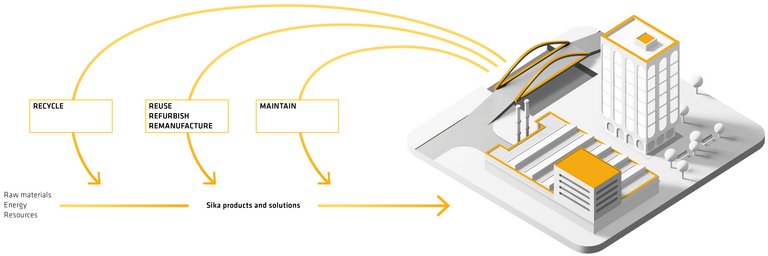Sika is leading the path to sustainability
Cities play a major role as economic engines, while also serving as hubs for knowledge, creativity, and innovation. Their immense potential can drive the widespread adoption of transformative concepts such as a circular economy.
CIRCULAR ECONOMY – THE WAY TO A SUSTAINABLE FUTURE
Circular economy offers practical solutions for mastering these challenges. A circular system keeps products and materials in circulation for as long as possible – by using, sharing, recycling, reusing, or repairing. It considers the product’s entire lifecycle, from sourcing the raw materials and design to production and distribution. This approach conserves resources, reduces waste, and cuts greenhouse gas emissions. In the construction industry alone, the circular economy could lower CO2 emissions by 38% by 2050, primarily by reducing the demand for steel, aluminum, and cement3. Therefore, cities have much to gain from circular practices.
INNOVATIVE SOLUTIONS FLOURISH IN CITIES
When it comes to sustainability in construction, one of the most effective strategies is to extend the lifespan of existing structures. Currently, approximately 50% of the building’s carbon emissions over its lifetime come from embodied carbon4 — the CO2 emitted during the production, transportation, and assembly of building materials. Half of the embodied carbon is found in materials, such as concrete, steel, and glass. Thus, by extending a construction’s lifespan, it reduces the carbon footprint of the structure, while also lowering overall costs. For example, a building with an additional 20 years of service could reduce costs by 25%, and lower the carbon footprint by 30%5. Reduced replacement rates also minimizes waste and resource consumption. This plays an increasingly important role on the construction industry’s path to net zero.

REDUCING TOTAL COST OF OWNERSHIP
Total cost of ownership is a key consideration in the construction of residential, commercial, as well as infrastructure projects. It addresses both the initial investment and long-term costs, such as maintenance, energy efficiency, and replacement. Durability and circularity are key strategies for reducing the total cost of ownership. Durability minimizes the long-term costs by extending the lifespan of assets. By prioritizing the use of high-performance solutions and robust designs, it can significantly reduce the frequency, as well as the costs of repairs and replacements. Circularity complements this approach by addressing material efficiency and waste reduction. Practices such as material reuse and incorporating recycled content, not only lowers disposal costs, but also supports environmental sustainability.
SIKA SOLUTIONS SUPPORT CIRCULARITY AND DURABILITY
Sika has been committed to sustainable development for many years. Sika’s expertise, for example, enables the “recycling” of skyscrapers, such as the renovation of the Quay Quarter Tower in Sydney, Australia. Instead of demolishing this iconic building, 95% of the structural walls were retained, avoiding 12,000 tons of carbon emissions and saving CHF 85 million6.
Moreover, reCO2ver® technology enables the complete recycling of concrete waste. The old concrete is broken down into its core components – aggregates, sand, and fine powder – in a simple process which also binds a significant amount of CO2. This innovation is particularly important given that the global demand for sand has tripled in recent decades, largely driven by the construction industry’s need to produce more concrete.
Sika also offers circular solutions such as the Sarnafil® roof membranes. Sika Sarnafil® membranes are retrieved from the customers at the end of their lifecycle, broken down into granulate, and then used to produce new roofing membranes. In the USA, 36,000 tons of material have already been recycled, reducing the CO2 emissions by 120,000 tons. In 2024, Sika extended its efforts to the EMEA region, recycling 50 tons of thermoplastic roofing, saving an additional 150 tons of CO2.
Sika’s macro-fiber technology has been recognized as a best practice by the World Business Council for Sustainable Development, showing that it reduces 20% CO2 per 150m3 slab-on-ground7 by eliminating steel mesh. In addition, macro-fibers save time, costs, and reduce waste in construction.
Real-time data monitoring, with systems, such as DuraMon and the SikaRoof® Monitoring System, allows for the continuous tracking of critical parameters like corrosion, water presence, or structural stress. These technologies not only identify issues but also provide predictive and actionable recommendations, extending asset lifespans. Moreover, digital tools like Sika’s Sand App and Mix Design App streamline construction processes, optimize material usage, and integrate environmental and performance data for smarter decision-making.
From recycling skyscrapers to breakthrough innovations, Sika is shaping a more sustainable and cost-efficient construction industry — one where circularity, durability, and performance come together seamlessly.
1 United Nations. Building Paris every week. Available here
2 Ellen MacArthur Foundation. Circular cities: thriving, liveable, resilient. Available here
3 Ellen MacArthur Foundation. Fixing the economy to fix climate change. Available here
4 World Green Building Council. Bringing embodied carbon upfront. Available here
5, 6 Sika’s estimation
7 World Business Council for Sustainable Development. Measuring the impact of carbon avoiding solutions. Available here
